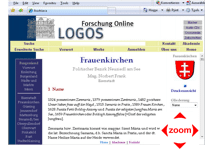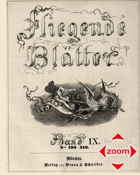| |
retrodig.a7111.com
Retrodigitalisation in the cultural and scientific sector
retrodig.a7111.com: retro-digitalisation in the cultural and scientific sector
frakturscript fliegende blaetter
Menü
Contact:
|
Retrodigitalisation
 The digitalisation of historical texts and documents is a multi-faceted task.
Alongside a true image rendition (facsimile) and optical character recognition (OCR),
the semantic recognition of content is rising in importance. For this reasons it is a necessity
to have cost-effective procedures and lasting document standards for digital long-time preservation,
which are suitable for both, the large amount and the significance of our historical heritage.
The digitalisation of historical texts and documents is a multi-faceted task.
Alongside a true image rendition (facsimile) and optical character recognition (OCR),
the semantic recognition of content is rising in importance. For this reasons it is a necessity
to have cost-effective procedures and lasting document standards for digital long-time preservation,
which are suitable for both, the large amount and the significance of our historical heritage.
A special concern is the digitalisation of fraktur-script, with more than one century of german
literature having been written in this gracefull script. The problem of "unavailable books"
can be seen in the same context: important scientific publications of last decades, frequently
cited and referred to by present works, will not be published any more.
The following paper gives a summary of the present situation shown from a national
and international point of view:

Austrian Book of of Towns and Cities (Burgenland)
 The Austrian Book of Towns and Cities, in it's republished version from 1991, shows the
problem of keeping books such as encyclopedias up to date. During the time of publication
the republished version was already lacking the newest information. This is where web
publications come in handy; not only is it easy to add new towns, but also to keep the
development of existing ones up to date.
The Austrian Book of Towns and Cities, in it's republished version from 1991, shows the
problem of keeping books such as encyclopedias up to date. During the time of publication
the republished version was already lacking the newest information. This is where web
publications come in handy; not only is it easy to add new towns, but also to keep the
development of existing ones up to date.
The following images show the introduction with the history of towns in Burgenland.
Due to copyright it is not possible to show the complete document.











Fliegende Blaetter
 The humorous and satiric paper "Fliegende Blätter" was full of illustrations and was
issued from 1845 to 1944 in Munich, in a weekly cycle. It was infamous not only for
its artistic content, but also for its high print quality. The papers were printed using
the woodblock technique until the year 1885, when henceforth the galvanic procedure
was used. The publisher provided the training for the engravers, in order to attain
best possible quality of illustration printing.
The humorous and satiric paper "Fliegende Blätter" was full of illustrations and was
issued from 1845 to 1944 in Munich, in a weekly cycle. It was infamous not only for
its artistic content, but also for its high print quality. The papers were printed using
the woodblock technique until the year 1885, when henceforth the galvanic procedure
was used. The publisher provided the training for the engravers, in order to attain
best possible quality of illustration printing.
Many of the illustrations in "Fliegende Blätter" were made by artists such
as Wilhelm Busch,
Carl Spitzweg, Moritz v. Schwind, Gustav Adolf Closs, Hans Kaufmann, Adolf Oberländer,
E. Harburger and René Reinicke.
One hundred years of German history: 200 volumes, more than 5000 numbers,
over 90000 pages. "Fliegende Blätter" truly is a unique masterpiece of the 19th
and 20th century, presenting politics in detail, as well as society and culture.
A never-ending panopticon and telescope back in time, from Metternich to
Wilhelm II. to the fall of the Third Reich.

|
|
|